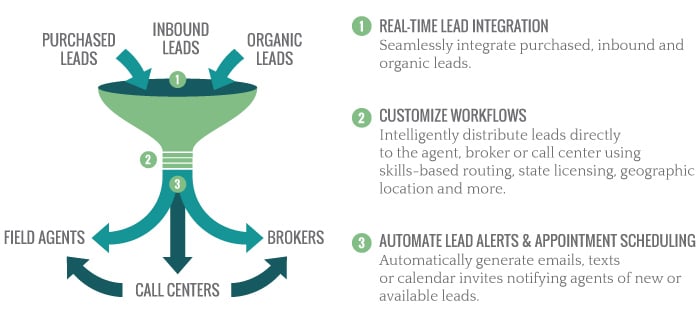The importance of technology platforms is ever-increasing in necessity among insurance agencies. More often than not, we see agencies using multiple platforms to manage their leads, quoting, enrollment and customer management which significantly impacts efficiency. In part one of our series on maximizing multi-channel distribution, we discuss agency roles, how these roles enhance the sales process, and why an all-in-one agency platform optimizes sales.
Establishing Team Member Profiles
There are some agencies that do it all, including telesales and captive and broker field sales, while others employ only a call center or field strategy. Regardless of how your agency is structured, understanding and defining team member profiles is key to creating strategic processes that maximize potential sales. Below we’ve defined seven profiles we see on a regular basis:
- Call Center Screeners/Qualifiers
- Call Center Licensed Agents
- Captive Field Agents
- Independent Brokers
- Verification/Customer Service
- Supervisors/Managers
- Executive Team
Many agencies now have non-licensed screeners that qualify leads and set appointments for the Licensed Agents. This is most common when answering inbound or dialing outbound calls to individuals that have not been previously qualified. (e.g. web leads, inbound calls from DRTV campaigns). Agents should be focused on running appointments and sales, and by using a technology platform that provides the ability for screeners and agents to be in one platform to view calendars, language spoken, and carrier appointment and licensing, agents can focus on eligible leads only.
When agents are focused solely on the sale and servicing of current clients, productivity significantly increases. Creating automated workflows such as happy birthday emails, appointment reminders or call-back notifications for routine tasks enhances the customer experience but also ensures agents are not held responsible for completing these tasks manually.
Including all sales representatives on a single platform means also incorporating your remote agents.
Remote agents working from their homes in various parts of the country are an increasingly popular sales model. We don’t mean a single, independent agent with their own book of business but remote agents that are part of a larger agency that may have zero brick and mortar presence but function as if they are located in the same office as one. Remote agents utilizing one technology platform allows for expansion into regions where there is no physical office. Recording calls, being able to transfer between screeners and agents, and ensuring that all agents are using the same systems is key to managing a successful remote agent system.
Few agencies today are employing verifiers. Verifiers, much like qualifiers, allow agents to focus on the sale as they handle all the administrative work associated submitting the application. If using the same technology platform, all the information input from the agent is transferred to the verifier, the verifier reviews the information with the client and submits the application. The sales pipeline becomes fully transparent in reporting when screener, agent, and verifier are all operating in the same customer record.
While not all independent brokers are receiving leads and pre-set appointments from your agency those that do are likely not sufficiently working the leads you provide them. Agents are guilty of calling a lead once or twice and then moving on to the next new lead meanwhile forgetting about the aged lead that could have resulted in a sale. Depending on the sales solution technology you utilize, you have the ability to require agents to disposition leads and assign leads only to the top producing brokers thus maximizing your marketing dollars and decreasing your cost per sale.
The Workflow
If you have the resources, we recommend leads initially flow through a qualifier/screener. Once these leads are qualified, they are transferred to a telesales agent or a pre-set appointment is set with a field agent. For leads that have been sent to the field it is key to monitor your lead life cycles via dashboards and custom reporting to reassign leads if they are insufficiently worked. For those leads that stay in the call center, utilize your technology to automate the distribution of these leads based on geography, agent skill set, disposition or lead source. Below is an illustrated view of a standard call center workflow.

No matter the distribution model, supervisors, managers, and the executive team need real-time data to make decisions. This data should tell a story of how the leads are being distributed, what the sources of these leads are and how qualifiers and agents are performing. This data allows the necessary changes to be made to maximize potential sales, and without it, company resources will be wasted.
Questions on team member profiles or establishing workflows? We’re here to help! We also have helpful information on optimizing your website for lead conversion.
 Login
Login


